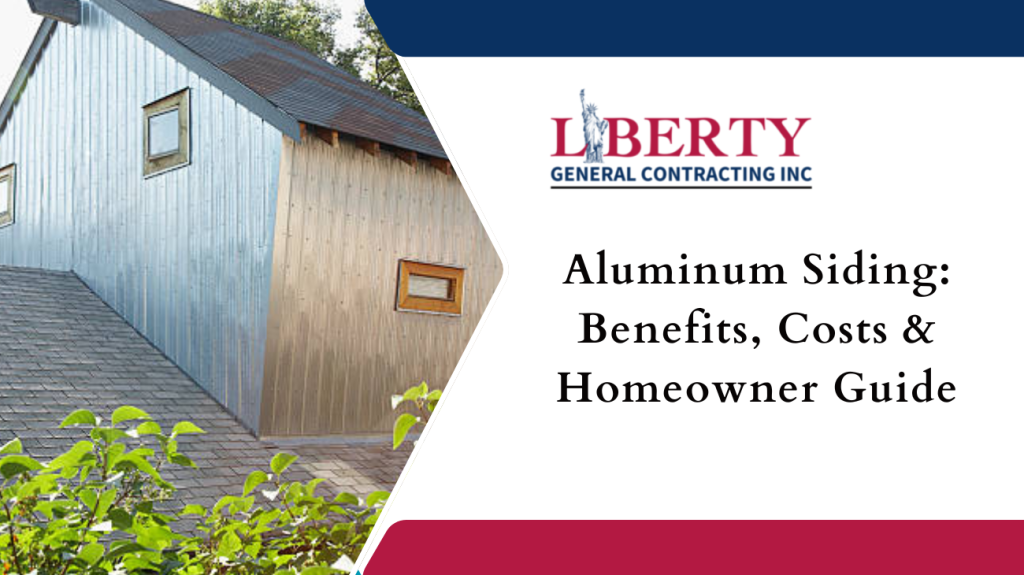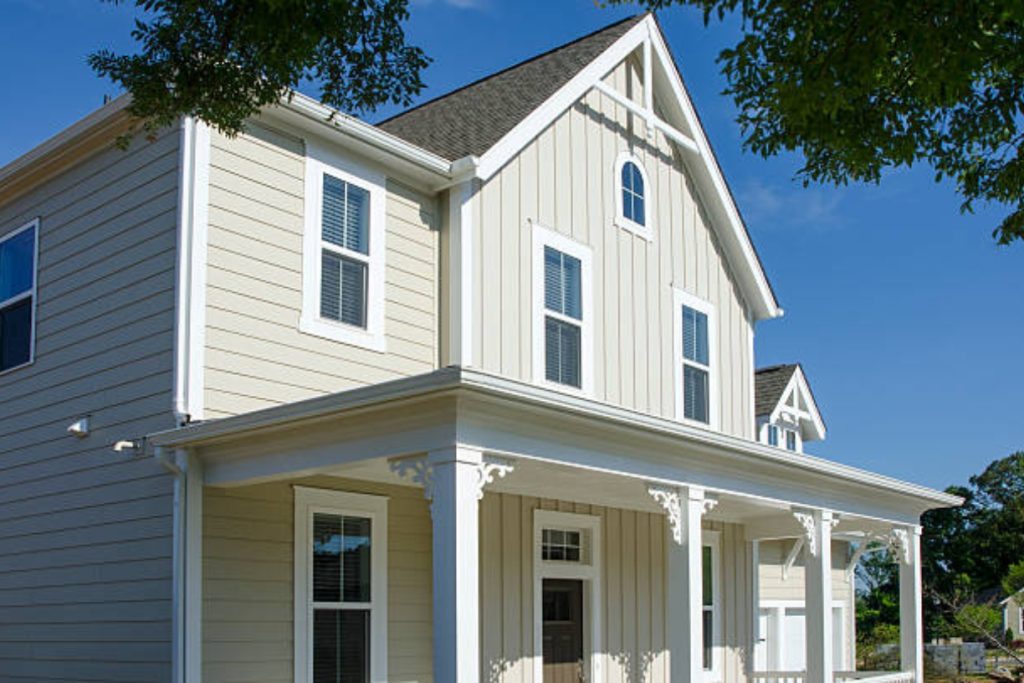When it comes to protecting your home’s exterior, aluminum siding is a popular and reliable choice that many homeowners consider. It offers durability, weather resistance, and a long lifespan, making it a strong competitor among siding materials. If you are planning to renovate your home or need a new type of siding that provides value for money, this guide will help you understand everything about aluminum siding in a very simple way.
This article will walk you through what aluminum siding is, its benefits, drawbacks, installation process, cost breakdown, maintenance tips, and why it may or may not be the right choice for your home.
What is Aluminum Siding?
Aluminum siding is an exterior cladding material made from aluminum sheets that are coated with paint or enamel to protect them from weather damage. It is lightweight, strong, rust-free, and commonly used in residential and commercial properties. Aluminum siding first became popular in the mid-20th century and continues to be used today because of its durability and low-maintenance features.

Why Homeowners Choose Aluminum Siding
Many homeowners prefer aluminum siding due to these key reasons:
- It resists rust, rot, and moisture damage
- It is fire-resistant and does not burn
- It offers long-term durability
- It is lightweight but strong
- It requires minimal maintenance
These benefits make aluminum siding a smart choice for homes located in areas with harsh climates, especially coastal regions with humidity and salty air.
Benefits of Aluminum Siding
1. Highly Durable and Long-Lasting
Aluminum siding can last 30 to 50 years or more with proper care.
It does not crack, warp, or get damaged easily, which means it stays strong against harsh sunlight, heavy rains, heat, and snow.
Because it does not absorb moisture, aluminum siding prevents mold or fungal growth, making it ideal for humid or coastal environments.
2. Low Maintenance Material
Compared to wood siding that needs repainting or sealing every few years, aluminum siding requires very little effort to maintain.
All it needs is an occasional wash with water and mild soap to remove dirt or dust. You do not need expensive cleaners or professional maintenance services regularly.
3. Fire-Resistant and Safe
One of the major advantages of aluminum siding is its fire resistance. Unlike wood or vinyl, aluminum does not burn. This can increase safety and reduce home insurance costs in some regions.
For homes located in wildfire-prone or hot regions, aluminum siding provides an extra layer of protection.
4. Excellent Insulation When Backed
Aluminum siding alone is not a great insulator, but when installed with a foam or insulated backing, it helps reduce heat loss and lowers energy bills.
This means your home stays cooler in summer and warmer in winter, helping you save on heating and cooling expenses.
5. Available in Many Styles and Colors
Aluminum siding comes in a wide range of:
- Colors
- Textures
- Finishes
- Designs
You can choose smooth, wood-grain, matte, or glossy finishes depending on the look you want for your home. It can even mimic the appearance of painted wood—but without the high maintenance required for real wood siding.
6. Eco-Friendly and Recyclable
If you are searching for an environmentally-friendly siding option, aluminum siding is 100% recyclable.
Unlike vinyl, it does not release harmful chemicals when disposed of.
Old aluminum siding can be melted and reused, making it a sustainable choice for eco-conscious homeowners.
Disadvantages of Aluminum Siding
Although aluminum siding has many advantages, it does have some drawbacks you should be aware of.
1. Can Dent or Scratch Easily
Because aluminum is a soft metal, it can dent or scratch from:
- Hail storms
- Strong impacts
- Children playing
- Moving furniture or ladders
These marks may become visible, especially on older siding, and might require repair or repainting.
2. Can Be Noisy
During heavy rain, wind, or hail, aluminum siding may produce a “pinging” or rattling sound.
This noise can be reduced by installing insulation beneath it, but some homeowners still find it noticeable.
3. Fading Over Time
Over years of sunlight exposure, the paint on aluminum siding can fade.
The color may become dull and require repainting every 10–15 years to keep it looking fresh.
4. Higher Upfront Cost
Aluminum siding can be more expensive at the time of installation compared to vinyl siding.
However, it lasts longer and requires less maintenance, which may save money in the long run.
Cost of Aluminum Siding
The cost of aluminum siding depends on the brand, design, insulation, and labor charges.
| Type of Cost | Average Price Range |
| Material only | $3 to $6 per square foot |
| Insulated aluminum | $6 to $10 per sq. ft. |
| Installation Labor | $2 to $5 per sq. ft. |
| Total Installed Cost | $8 to $15 per sq. ft. |
For a standard 1,500 sq. ft. home, the total cost may range from $12,000 to $22,500.
Although aluminum siding is not the cheapest siding option, the long lifespan and low upkeep make it a valuable investment.
Installation Process of Aluminum Siding
The installation of aluminum siding should be done by a professional to avoid damage. Below is a simple explanation of the steps involved:
Step-by-Step Installation
- Inspection & Preparation:
The old siding is removed, walls are checked for damage, and surface is cleaned. - Add Insulation or Backing:
Optional but recommended—foam or insulation boards are added for improved energy efficiency. - Install Starter Strips and Trim:
This helps align the siding panels correctly. - Attach Aluminum Panels:
Panels are installed from bottom to top and secured with nails carefully to allow slight movement. - Finishing Touches:
Corners, edges, and window areas are sealed, and paint touch-ups are done if required.
Maintenance Tips for Aluminum Siding
To keep aluminum siding looking clean and new, follow these simple maintenance steps:
1. Regular Cleaning
Wash the siding once or twice a year using:
- Soft brush or cloth
- Mild soap
- Water hose
Avoid pressure washing because strong water pressure can remove paint or cause dents.
2. Repair Dents or Scratches
Small dents can sometimes be repaired using a rubber mallet. For deep dents, replacement of the affected panel is best.
Also, apply touch-up paint to scratched areas to prevent oxidation.
3. Repaint Every 10–15 Years
Repainting aluminum siding refreshes the exterior and protects it from sun damage.
Use paint designed for metal surfaces for long-lasting results.
Is Aluminum Siding the Right Choice for You?
Choose aluminum siding if:
- You live in an area with humidity, rain, or salty coastal air
- You want a long-lasting and low-maintenance siding
- You prefer a fire-resistant and eco-friendly material
- You want a siding that does not rot, warp, or attract pests
However, it may not be the best option if you are worried about dents, noise, or the need to repaint after several years.
Final Thoughts
Aluminum siding remains one of the most trusted and durable siding materials for both modern and traditional homes. It offers excellent weather protection, energy efficiency (when insulated), low maintenance, and eco-friendly benefits. While it may cost more upfront and can dent or fade over time, its long life and minimal repair needs make it a smart investment.
Contact Liberty GCNY
Website: www.libertygcny.com
Phone: (347) 682-9840
Serving: Manhattan, Brooklyn, Queens, The Bronx, Westchester County, and Long Island.
Address: 251 N Regent St, Port Chester, NY 10573, United States
Need Help with Your Next Project? Call Liberty GCNY Today!
Fast responses. Expert advice. Trusted service across NYC and beyond.


